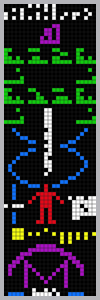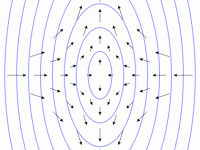
This is the message with color added to highlight its separate parts.
On May 28, 1930, American astronomer and astrophysicist Frank Drake was born. He is most notable as one of the pioneers in the search for extraterrestrial intelligence, including the founding of SETI, mounting the first observational attempts at detecting extraterrestrial communications in 1960 in Project Ozma, developing the Drake equation, and as the creator of the Arecibo Message, a digital encoding of an astronomical and biological description of the Earth and its lifeforms for transmission into the cosmos.[5]
“Only by doing the best we can with the very best that an era offers, do we find the way to do better in the future.”
– Frank Drake
Background Frank Drake
Frank Drake was born on May 28, 1930 in Chicago, Illinois. He enrolled at Cornell University on a Navy Reserve Officer Training Corps scholarship. Once there he began studying astronomy. His ideas about the possibility of extraterrestrial life were probably reinforced by a lecture from astrophysicist Otto Struve in 1951. After college, he served briefly as an electronics officer on the heavy cruiser USS Albany. He then went on to graduate school at Harvard to study radio astronomy.
Drake undertook radio astronomical research at the National Radio Astronomy Observatory in Green Bank, West Virginia and later the Jet Propulsion Laboratory. He conducted key measurements which revealed the presence of a Jovian ionosphere and magnetosphere. Then in the 1960s, Frank Drake became one of the initiators to convert the Arecibo Observatory to a radio astronomical facility. He was also involved in the early work on pulsars and professor at Cornell University as well as Director of the National Astronomy and Ionosphere Center.
Project Ozma
Project Ozma was launched in April 1960 and is named after the princess of Oz. The project’s objective was to search for signs of life in distant solar systems through interstellar radio waves. Frank Drake used a radio telescope with a diameter of 26 metres to examine the stars Tau Ceti and Epsilon Eridani near the 1.420 gigahertz marker frequency. Both stars are nearby and Sun-like. The scientists believed that they were likely to have inhabited planets. A 400 kilohertz band was scanned around the marker frequency, using a single-channel receiver with a bandwidth of 100 hertz. The information was stored on tape for off-line analysis. Some 150 hours of intermittent observation during a four-month period detected no recognizable signals.
Arecibo Message
In 1974, Frank Drake wrote with the help of Carl Sagan and further scientists the Arecibo message.[4] The message consisting of 1,679 binary digits was broadcast into space a single time via frequency modulated radio waves at a ceremony to mark the remodeling of the Arecibo radio telescope in Puerto Rico. The message was aimed at the current location of globular star cluster M13 some 25,000 light years away because M13 was a large and close collection of stars that was available in the sky at the time and place of the ceremony. The famous message consisted of seven parts that encode the numbers one to ten, the atomic numbers of several elements as well as the formulas for the sugars and bases in the nucleotides of DNA and the number of nucleotides in DNA, and a graphic of the double helix structure of DNA. Further, the message contained graphic figures of a human and Earth’s population, of the Solar System, and the Arecibo radio telescope. It was estimated that the message would take 25.000 years to reach its destination and the core of M13, to which the message was aimed, will no longer be in that location when the message arrives. According to the Cornell News press release of November 12, 1999, the real purpose of the message was not to make contact but to demonstrate the capabilities of newly installed equipment.
Shane L. Larson, Astro 111 – Astrobiology: Lecture 24b — The Arecibo Message, [9]
References and Further Reading:
- [1] Project Ozma and the Arecibo message at SETI
- [2] Frank Drake at SETI
- [3] Frank Drake at Space.com
- [4] Carl Sagan’s Cosmos, SciHi Blog
- [5] The Arecibo Radio Telescope – Looking for Extraterrestrial Signals, SciHi Blog
- [6] Frank Drake at Wikidata
- [7] “Cornell News: It’s the 25th anniversary of Earth’s first (and only) attempt to phone E.T.” Nov 12, 1999.
- [8] Johnson, Steven (28 June 2017). “Greetings, E.T. (Please Don’t Murder Us.)”. The New York Times.
- [9] Shane L. Larson, Astro 111 – Astrobiology: Lecture 24b — The Arecibo Message, sciencejedi @ YOUTUBE
- [10] Timeline of American Astronomers via DBpedia and Wikidata





